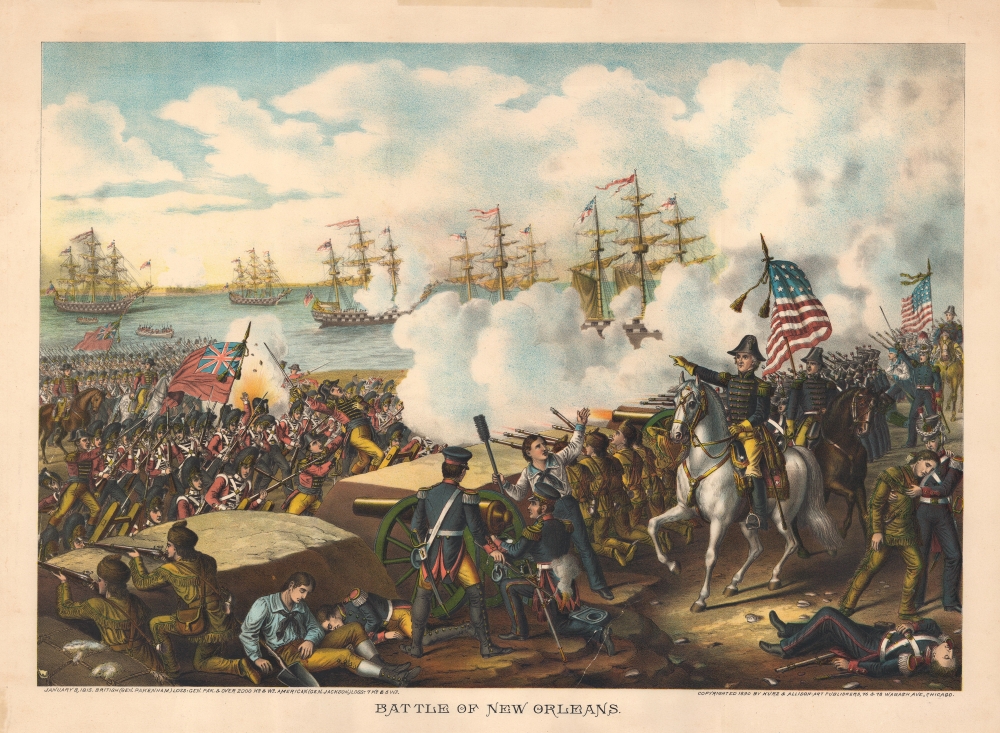1890 Kurz and Allison Print, Battle of New Orleans, War of 1812
BattleNewOrleans-kurzallison-1890
Title
1890 (dated) 17.5 x 25 in (44.45 x 63.5 cm)
Description
A Closer Look
This view is oriented towards the southeast, with the Mississippi River, dominated by British ships, in the background. It depicts the January 8, 1815 British attack on American positions along the Rodriguez Canal, a small creek next to a sugarcane field on the outskirts of New Orleans. At right, Andrew Jackson sits decisively atop a white horse giving orders, while a British officer, likely meant to be Gen. Pakenham, is mortally wounded while leading the assault. The view partly reflects the ragtag, multiracial makeup of the defenders.The Battle of New Orleans
A remarkable encounter in every way, the 1815 Battle of New Orleans had a significant impact on the future direction of the United States, most notably by elevating Andrew Jackson to national prominence. The battle took place after the Treaty of Ghent ending the War of 1812 had already been signed, but news of it had not yet reached America, nor had it been approved by Congress. It was also notable for the lopsided casualty numbers between the British and Americans.The battle came at the end of the Gulf Campaign, a British attempt to gain control of the mouth of the Mississippi and challenge American territorial claims following the Louisiana Purchase. This approach made New Orleans the site of a decisive battle. British preparations proceeded smoothly, but American commander Andrew Jackson, sensing the likelihood and direction of the British attack, prepared formidable defenses.
Constructing a defensive line ('Line Jackson') at the Rodriguez Canal, Jackson was able to fend off British probing attacks and further fortify his position in late December 1814 and early January 1815. A combination of poor decisions by British commanders and effective leadership by Jackson allowed the American force, composed of an assemblage of militia units, Jean Lafitte's Baratarian pirates, Native American (Choctaw) allies, and volunteers from throughout the American South, including Black freedmen, to mount a successful defense.
A full-scale British assault directly into American artillery fire on January 8 was repelled with minimal casualties for the defenders (Kurz and Allison exaggerate the relatively low number of American casualties here), while roughly one-quarter of the British force was killed or wounded, including most of its officers. As a result, British designs on the former French Louisiana were crushed, Jackson became a national hero, and the Federalist Party, which was clamoring for peace with Britain and considering the secession of New England states from the Union on the eve of the battle, was undermined as a political force. In the mid-late 19th century, the Chalmette Monument was constructed near the site of the battle.
Chromolithography
Chromolithography, sometimes called oleography, is a color lithographic technique developed in the mid-19th century. The process involved using multiple lithographic stones, one for each color, to yield a rich composite effect. Oftentimes, the process would start with a black basecoat upon which subsequent colors were layered. Some chromolithographs used 30 or more separate lithographic stones to achieve the desired product. Chromolithograph color could also be effectively blended for even more dramatic results. The process became extremely popular in the late 19th and early 20th centuries when it emerged as the dominant method of color printing. The vivid color chromolithography produced made it exceptionally effective for advertising and propaganda imagery.Publication History and Census
This print was produced and published by the firm Kurz and Allison in Chicago in 1890. We note it among the collections of four institutions (the Library of Congress, the Tennessee State Library and Archives, the Gilder Lehrman Institute of American History, and the Huntington Library).Cartographer
Kurz and Allison (1880 - c. 1905) was an American publishing firm known for its chromolithographs. Founded by Louis Kurz (1835 - 1921) and Alexander Allison, the firm was based at 267-269 Wabash Avenue in Chicago. In the partnership, it is known that Kurz, an Austrian immigrant, was the lithographer and it is presumed that Allison provided the financial backing. The firm is most well-known for its series of thirty-six battle scenes from the American Civil War. At the time of their publication, the late 1880s and early 1890s, a general nostalgia was prevalent among Civil War veterans (of which Kurz was one), and evidently the company was trying to capitalize on the sentiment. Kurz and Allison's Civil War prints were not the first such prints to be issued, but they were by far the most popular. In a style reminiscent of Currier and Ives, Kurz and Allison lithographs are not meant to be historical representations, and even, from time to time, included historical inaccuracies. Even so, 'prints depicting the Civil War battles by Kurz and Allison are among the most sought-after collectibles of Civil War enthusiasts.' Their prints are also notable for featuring African-American soldiers, a rarity for the era. After the outbreak of the Spanish-American War, the firm published views from famous battles and continued doing so for the campaigns of the Philippine-American War and the Russo-Japanese War. More by this mapmaker...

